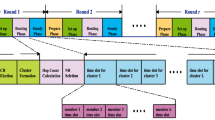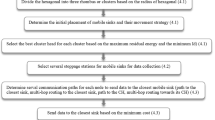Abstract
Wireless sensor networks (WSNs) usually consist of unmanned and self-organized sensor devices deployed on a target region for monitoring and target tracking purposes. Therefore, extending the lifetime of WSNs is critical to their proper operation. Static sink schemes have been studied extensively and several solutions were proposed to extend the lifetime of WSNs. Such static solutions are known for their bottleneck in the vicinity of a sink, where sensor nodes are more likely to be used as data forwarding points to a nearby sink. These nodes carry most of the data traffic and consequently deplete their energy resources faster than nodes deployed far off static sinks, which end up creating blind spots or even network partitions. A partitioned, i.e., disconnected network will cease to function properly in view of sink stations becoming unreachable. The consensus reached by the research community to solve this bottleneck, or at least to alleviate traffic and energy consumption near data sinks, is the use of mobile sinks. To this end, this paper presents a new data dissemination strategy (eTrail) that combines clustering, trail generation, and sleep scheduling techniques to extend network lifetime even further. Network lifetime is modeled and analyzed by means of a continuous time Markov chain. In addition, an extensive set of simulation experiments is presented and discussed. Results show that eTrail outperforms existing schemes in terms of network lifetime, while maintaining acceptable packet delivery reliability and latency.










Similar content being viewed by others
References
Azad, A. P., & Chockalingam, A. (2006). Mobile base stations placement and energy aware routing in wireless sensor networks. IEEE on Wireless Communications and Networking Conference (WCNC), 1, 264–269.
Basagni, S., Carosi, A., Melachrinoudis, E., Petrioli, C., & Wang, Z. M. (2008). Controlled sink mobility for prolonging wireless sensor networks lifetime. Wireless Networks, 14(6), 831–858.
Bhuiyan, M., Wang, G., & Vasilakos, A. (2015). Local area prediction-based mobile target tracking in wireless sensor networks. IEEE Transactions on Computers, 64(7), 1968–1982. doi:10.1109/TC.2014.2346209.
Boukerche, A. (2008). Algorithms and protocols for wireless, mobile ad hoc networks (Vol. 77). London: Wiley.
Chatzigiannakis, I., Kinalis, A., & Nikoletseas, S. (2006). Sink mobility protocols for data collection in wireless sensor networks. In Proceedings of the 4th ACM international workshop on mobility management and wireless access, MobiWac ’06, pp. 52–59
Chen, M., Wan, J., Gonzalez, S., Liao, X., & Leung, V. (2014). A survey of recent developments in home m2m networks. IEEE on Communications Surveys Tutorials, 16(1), 98–114. doi:10.1109/SURV.2013.110113.00249.
Di Francesco, M., Das, S. K., & Anastasi, G. (2011). Data collection in wireless sensor networks with mobile elements: A survey. ACM Transactions on Sensor Networks, 8(1), 7:1–7:31.
Fodor, K., & Vidács, A. (2007). Efficient routing to mobile sinks in wireless sensor networks. In Proceedings of the 3rd international conference on wireless internet, WICON’07, pp. 1–7. ICST, Brussels, Belgium
Gandham, S. R., Dawande, M., Prakash, R., & Venkatesan, S. (2003). Energy efficient schemes for wireless sensor networks with multiple mobile base stations. In Global Telecommunications Conference, 2003 (GLOBECOM '03) (Vol. 1, pp. 377–381), 1–5 December 2003. IEEE. doi:10.1109/GLOCOM.2003.1258265.
Gu, Y., Ji, Y., Li, J., & Zhao, B. (2013). Eswc: Efficient scheduling for the mobile sink in wireless sensor networks with delay constraint. IEEE Transactions on Parallel and Distributed Systems, 24(7), 1310–1320.
Gu, Z., Hua, Q.S., Wang, Y., & Lau, F. (2013). Reducing information gathering latency through mobile aerial sensor network. In Proceedings IEEE on INFOCOM, 2013, pp. 656–664
Hamida, E., & Chelius, G. (2008). A line-based data dissemination protocol for wireless sensor networks with mobile sink. In IEEE international conference on communications, ICC ’08., pp. 2201–2205
Han, K., Luo, J., Liu, Y., & Vasilakos, A. (2013). Algorithm design for data communications in duty-cycled wireless sensor networks: A survey. IEEE on Communications Magazine, 51(7), 107–113. doi:10.1109/MCOM.2013.6553686.
Khan, M. I., Gansterer, W. N., & Haring, G. (2013). Static vs. mobile sink: The influence of basic parameters on energy efficiency in wireless sensor networks. Computer Communications, 36(9), 965–978. Reactive wireless sensor networks.
Li, M., Li, Z., & Vasilakos, A. (2013). A survey on topology control in wireless sensor networks: Taxonomy, comparative study, and open issues. Proceedings of the IEEE, 101(12), 2538–2557. doi:10.1109/JPROC.2013.2257631.
Liu, X. Y., Zhu, Y., Kong, L., Liu, C., Gu, Y., Vasilakos, A., et al. (2015). Cdc: Compressive data collection for wireless sensor networks. IEEE Transactions on Parallel and Distributed Systems, 26(8), 2188–2197. doi:10.1109/TPDS.2014.2345257.
Luo, J., & Hubaux, J. P. (2005). Joint mobility and routing for lifetime elongation in wireless sensor networks. In 24th Annual Joint Conference of the IEEE Computer and Communications Societies (INFOCOM 2005), Proceedings IEEE (Vol. 3, pp. 1735–1746), 13–17 March 2005. IEEE. doi:10.1109/INFCOM.2005.1498454.
Luo, J., Panchard, J., Pirkowski, M., Grossglauser, M., & Hubaux, J. P. (2006). Mobiroute: Routing towards a mobile sink for improving lifetime in sensor networks. Distributed Computing in Sensor Systems, LNCS, 4026, 480–497.
Marta, M., & Cardei, M. (2009). Improved sensor network lifetime with multiple mobile sinks. Pervasive and Mobile Computing, 5(5), 542–555.
Memsic iMote2 IPR2400 Processing and Sensing Board—Data Sheet (2014).
Pazzi, R. W., & Boukerche, A. (2008). Mobile data collector strategy for delay-sensitive applications over wireless sensor networks. Computer Communications, 31(5), 1028–1039.
Rault, T., Bouabdallah, A., & Challal, Y. (2013). Wsn lifetime optimization through controlled sink mobility and packet buffering. In Global information infrastructure symposium, 2013, pp 1–6.
Sengupta, S., Das, S., Nasir, M., Vasilakos, A., & Pedrycz, W. (2012). An evolutionary multiobjective sleep-scheduling scheme for differentiated coverage in wireless sensor networks. IEEE Transactions on Systems, Man, and Cybernetics, Part C: Applications and Reviews, 42(6), 1093–1102. doi:10.1109/TSMCC.2012.2196996.
Shin, J. H., Kim, J., Park, K., & Park, D. (2005). Railroad: Virtual infrastructure for data dissemination in wireless sensor networks. In Proceedings of the 2Nd ACM international workshop on performance evaluation of wireless ad hoc, sensor, and ubiquitous networks, PE-WASUN ’05, pp. 168–174.
Turgut, D., & Bölöni, L. (2011). Heuristic approaches for transmission scheduling in sensor networks with multiple mobile sinks. The Computer Journal, 54(3), 332–344.
Vass, D., & Vidács, A. (2005). Positioning mobile base station to prolong wireless sensor network lifetime. In Proceedings of the 2005 ACM conference on emerging network experiment and technology, CoNEXT ’05, pp. 300–301.
Vecchio, M., Viana, A. C., Ziviani, A., & Friedman, R. (2010). Deep: Density-based proactive data dissemination protocol for wireless sensor networks with uncontrolled sink mobility. Computer Communications, 33(8), 929–939. doi:10.1016/j.comcom.2010.01.003.
Vincze, Z., Vass, D., Vida, R., Vidács, A., & Telcs, A. (2006). Adaptive sink mobility in event-driven multi-hop wireless sensor networks. In Proceedings of the first international conference on integrated internet ad hoc and sensor networks, InterSense ’06.
Wang, G., & Wang., T. (2007). Local update-based routing protocol in wireless sensor networks with mobile sinks. In Proceedings of the 2007 IEEE international conference on communications, ICC’07, pp. 3094–3099.
Wang, G., Wang, T., Jia, W., Guo, M., & Li, J. (2009). Adaptive location updates for mobile sinks in wireless sensor networks. Journal of Supercomputing, 47, 127–145.
Wang, Z., Basagni, S., Melachrinoudis, E., & Petrioli, C. (2005). Exploiting sink mobility for maximizing sensor networks lifetime. pp. 287a–287a.
Wu, X., & Chen, G. (2007). Dual-sink: Using mobile and static sinks for lifetime improvement in wireless sensor networks. pp. 1297–1302.
Yao, Y., Cao, Q., & Vasilakos, A. (2015). Edal: An energy-efficient, delay-aware, and lifetime-balancing data collection protocol for heterogeneous wireless sensor networks. IEEE/ACM Transactions on Networking, 23(3), 810–823. doi:10.1109/TNET.2014.2306592.
Zeng, Y., Xiang, K., Li, D., & Vasilakos, A. (2013). Directional routing and scheduling for green vehicular delay tolerant networks. Wireless Networks, 19(2), 161–173. doi:10.1007/s11276-012-0457-9.
Author information
Authors and Affiliations
Corresponding author
Additional information
This work is partially sponsored by the Natural Sciences and Engineering Research Council of Canada (NSERC), Discovery Grant Program, and the NSERC DIVA Strategic Research Network.
Rights and permissions
About this article
Cite this article
Pazzi, R.W., Boukerche, A., De Grande, R.E. et al. A clustered trail-based data dissemination protocol for improving the lifetime of duty cycle enabled wireless sensor networks. Wireless Netw 23, 177–192 (2017). https://doi.org/10.1007/s11276-015-1089-7
Published:
Issue Date:
DOI: https://doi.org/10.1007/s11276-015-1089-7




